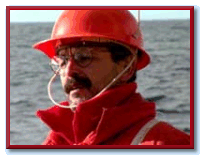
David Karl
Oceanographer

|
"A Note on the Science of Sediment Traps" David Karl Oceanographer |
|
(A note for teachers and older students from oceanographer David Karl
on the Science of Sediment traps -- see Deane's Journal from the Polar Duke,
for the hair-raising tale of recovering the traps and the winch mishap!) Along with the automatic weather station data, they are THE ONLY YEAR LONG
activity in our Long-Term Ecological Research project. Antarctica is well
known for its change of seasons even though the leaves do not fall. Scientific
information collected during austral winter is sparse and the LTER personnel
are not in the field at this time. However, the weather stations and the
sediment trap moorings continue their duty. In the case of the sediment traps, we have a built in computer that directs
the operation from under the sea. At a series of predetermined times that
I program into the seabed computer, the trap computer sends a pulse to the
trap rotary motor and a new sample cup is moved into position. This continues
until all 21 separate samples are collected and successfully back on board
ship for further analyses. Once the computer is reprogrammed and new sample
bottles are positioned on the rotation plate, the entire array is redeployed
for another year of data collection. The sediment traps are essentially worthless on the deck of the ship
-- hence our desire and efforts to "turn them around" as quickly
as possible. The samples are transported to our home laboratories for a
systematic and comprehensive analysis of bioelements (life's building blocks)
-- carbon, nitrogen, phosphorus, silica, as well as other lithogenic phases.
We view the sample materials under the microscope for characterization of
the organic and inorganic matter that is collected. Why do we care about this? The ability of the ocean to sequester atmospheric
carbon dioxide -- rising in response to humanity's use of the planet's fossil
fuel stores -- is largely dependent upon the rate of export of organic matter
from the near surface waters of the sea. This process, called the biological
pump, ultimately fuels all (or in effect most, excluding the deep sea hydrothermal
vents) subeuphotic zone (below the lighted zone) organisms and is a vital
measurement in fisheries' oceanography. As mentioned above, this is also
the mechanism whereby carbon is sequestered into the deeper portions of
the world ocean and represents the primary oceanic sink (although perhaps
only temporary - 100-1000 years) for fossil fuel. This is an important area of contemporary oceanography and our efforts
in Antarctica are part of an international network of particle flux experiments
currently underway. The sediment trap research is part of the "microbiology
and carbon flux" component of LTER. In addition to this work, we also
measure all pools of carbon in the sea (the largest are dissolved inorganic
and dissolved organic carbon) and we make inventories of the numbers and
metabolic activities of microorganisms from bacteria to protozoans, including
viruses. These data collectively define the microbial loop or microbial
foodweb that is so vital to the economy of the sea both in Antarctica and
elsewhere. We also conduct a similar set of experiments at a subtropical North Pacific
Ocean site, called Station ALOHA (A Longterm Oligotrophic Habitat Assessment).
This research is also funded by NSF and is a North Pacific barometer for
global environmental change. We visit that site about once per month and
have been doing so since Oct 1988. The Hawaii effort is called "Hawaii
Ocean Time-series" (HOT), and the Antarctica effort is called "Coupled
Ocean-ice Linkages and Dynamics" (COLD); hence the lab logo, HOT &
COLD! You can learn more at my homepage: http://hahana.soest.hawaii.edu Hope this helps. |
|||
| Back to Field Journals Menu | David Karl's BIOgraphy | A Note on the Science of Sediment Traps 1 | |
![]()